
COCO-DE-MER
SCIENTIFIC NAME: Lodoicea maldivica
FAMILY: Borasseae
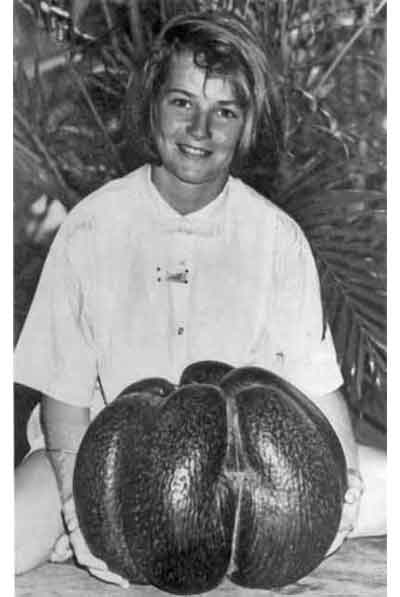 Referred to as one of the most famous palms in the world, it can be compared with the most celebrated members of the Vegetable Kingdom, such as the biblical Lebanon Cedar or the Giant Sequoia of California.
Referred to as one of the most famous palms in the world, it can be compared with the most celebrated members of the Vegetable Kingdom, such as the biblical Lebanon Cedar or the Giant Sequoia of California.
Coco-de-Mer is also known as Sea Coconut or Double-Coconut and is the most remarkable one of the six monotypic palms of the Seychelles. It belongs to the Borasseae, sub-family of the large Palmae family.
The coco-de-mer has its origins in the Seychelles group of islands, which lie off the East Coast of Africa, 4° South of the Equator in the Indian Ocean. The Seychelles are the only granitic islands in the world and it is on the island of Praslin, where the 4000-odd coco-de-mer trees flourish.
Fascinating is the distribution of the coco--de-mer palm. It grew on a group of only five islands, on Praslin, Curieuse and on three neighbouring islets. Today it's only growing on Praslin and Curieuse, having disappeared from the islets. The reason why the coco-de-mer existed on only five islets of the Seychelles is a mystery.
One theory put forward is that the micro continent, of which the Seychelles granitic islands are believed to be remnants, split and largely disappeared in geological times. Numerous species of plants, which could not adapt themselves to their changing habitat, would have become extinct. Some, like the coco-de-mer found themselves confined to certain islands and islets. In the case of the coco-de-mer, this isolation was definite, since three factors stood in the way of dispersing the species.
1. The heaviness of the coco-de-mer nut, which when fresh, and therefore capable of germination, is heavier than water, which prevented it being carried on the sea to another land.
2. The uni-sexuality of the palm, which required the establishment of at least a staminate and pistillate palm in a new location to carry on the species.
3. The gregariousness of the palm, since coco-de-mer fructifies well and is able to perpetuate itself only when it grows as a community.
In keeping with the fascinating facts about the coco-de-mer, its germinating process is also unique. After the nut hits the ground, a period of six months elapses, during which the thin husk of the fruit rots. A shoot, carrying the embryo in a cavity in its slightly swollen tip appears from the sinus between the two lobes of the nut. It penetrates the soil to a depth of about 0.6 m, but if a stone blocks the root system it can extend horizontally for up to 3.65 m before turning down into the soil.
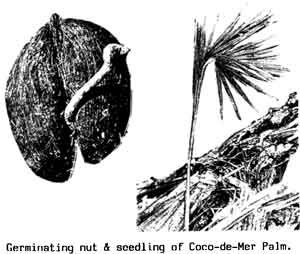
When the primary root reaches the required depth, the embryo starts to grow, producing a taproot and spreading lateral roots. At the same time the embryo shoot grows up.
The young shoot grows to about 0.3-0.6m above the ground. It's only then, about a year after germination has started, that the sheath splits and the first leaf appears in the air. For a further two years the seedling will continue to receive nourishment from the nut, before the shoot-like structure rots and becomes independent from the now-hollow nut.
Another interesting trait of the coco-de-mer is the extreme slowness of its growth. While the nut takes some three years to germinate and seven years to reach maturity, the palm itself takes 25 years to start bearing and nearly a millennium to reach full size, which is about 30m for the male and 24m for the female. It has been estimated that the tallest coco-de-mer palms of the Vallee de Mai are over 800 years old.
The palm is very tall with an extremely clean and straight trunk. Three to four large, shiny light green leaves, which have a span of 6-7. 5m long and 4. 25m wide are produced every year. It's truly unique among trees and is referred to as "Prince of Palms."
The coco-de-mer have male and female flowers in separate plants of the same species. That's why the trees love to grow side by side. The male and female flowers are arranged in the axil of the leaves. The numerous star-shaped, yellow, fragrant male flowers hang in a large pointed cluster, which measures the size and thickness of a man's arm.
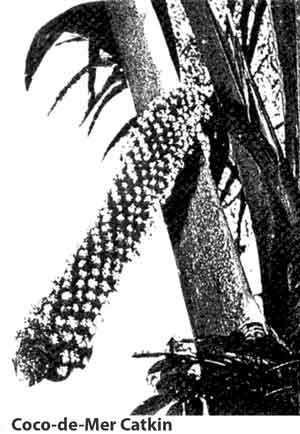
The 5-13 female flowers attract no attention and are arranged on a thick 0.6m zig zag axis. They are covered by large, hard, reddish-brown leaves, which grow at the base of the flower.
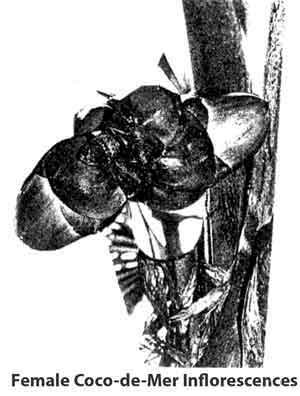
According to a Seychelles legend, it is deadly to witness an amorous encounter between the male and female coco-de-mer palms, which meet and unite by stormy nights.
After fertilisation, generally one of the three female ovules develops and produces a bi-lobed nut. Sometimes two or even all ovules develop and two, three and even in rare cases four lobed nuts are produced.
Three to four bunches are produced each year, each having three to five, but up to ten nuts. In extreme cases, bunches have been known to weigh 180 kg.
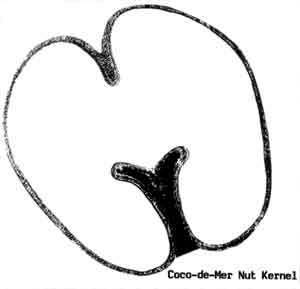
The exterior of the nut looks like a huge green heart, 0.30-0.45m in diameter and weighs 13-18 kg. When opened, the nut looks like a belly and thighs.
The coco-de-mer nut, when green at nine months, contains a delicately sweet jelly. When mature, the coco-de-mer fruit has a hard, ivory-like kernel, which has the reputation of being a potent aphrodisiac.
The medicinal properties of the coco-de-mer are legendary. As early as 1500, the existence of the nut was known by the then-master mariners, the Portuguese. Without naming the coco-de-mer, it was spoken of as "tree that grows under the sea and had medicinal properties, superior to those of the precious stone Bezoar".
Garcia de Orta, in his dialogues on India's Pharmacopaeia, which was published in Goa in 1563, says that the then-called "Maldive Coconut" comes from palm trees and that the kernel of the nut is an excellent remedy against poisons, colic, paralysis, epilepsy and numerous other nervous disorders, as well as against bowel disease.
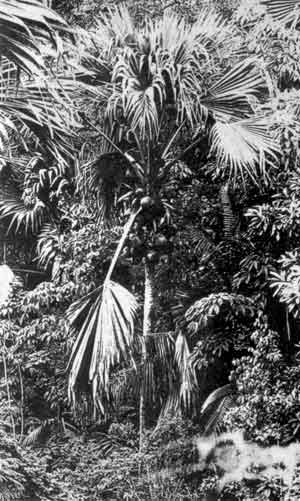
The root system of the coco-de-mer is shallow, but extremely powerful. The "Bowl" which has intrigued botanists for many years, is a large semi-circular bowl-like structure. It's made up of hard durable tissue, which looks like the shell of the coco-de-mer nut and has a diameter of 0.45-0.75m and a depth of 0.15-0.25m. The bowl is found at the base and the socket fits the bulbous base of the palm. It lasts for up to as long as 60 years after a tree has died or has been felled.
The timber, which is light brown in colour and speckled with ebony black dots, hasn't been used much, as it rots too easily. The nuts are used extensively for many purposes. The leaves have been used for artistic twining and thatching roofs and partitions.
The Seychelles must have been known to Arab and other Indian Ocean navigators as early as 916. The Portuguese talked about the Seychelles in the 15-16th century. However, it's the English that are owed the first recorded landings in the 17th century. A French sea captain, Lazare Picault, discovered the coco-de-mer in 1744.
Through the early European explorers, coco-de-mer nuts were introduced to Europe where they became quite fashionable. Kings and Princes were among many eager to acquire one of the fabulous nuts. Rudolf II, of the Hapsburgs, offered 4000 gold florins for one nut.
So highly prized were the coco-de-mer nuts, that many were mounted in gold and silver. The coco-de-mer can also be found in some other countries of a similar climate to that of the Seychelles. There are several in Sri Lanka and Hawaii for instance, but all of these were brought in by man.
DATE: November 1986
* * * * * * * * * * * * *
